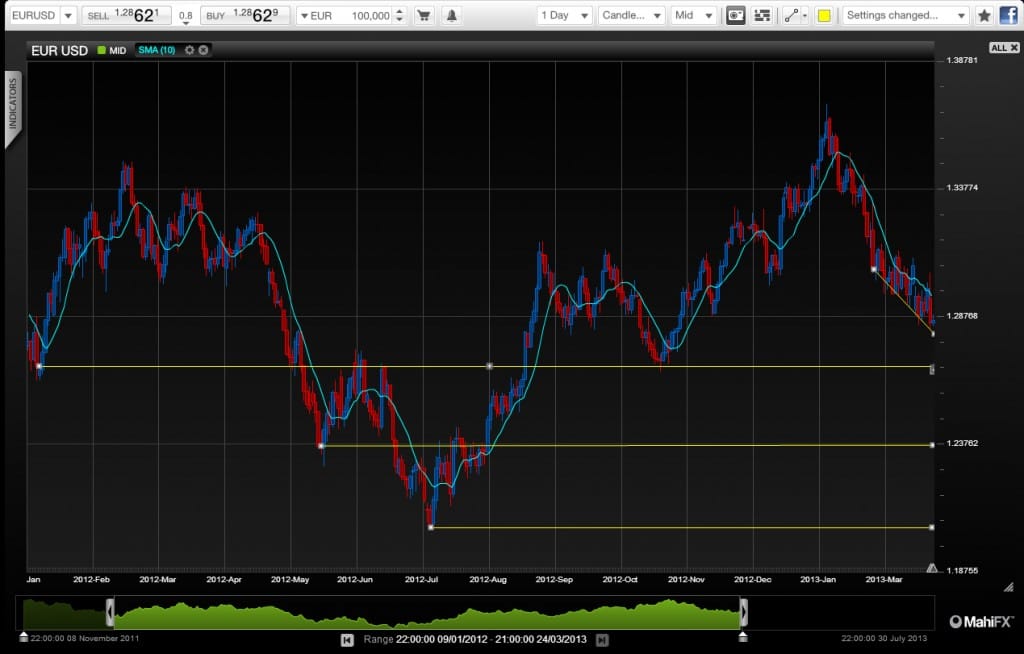By Justin Pugsley, Markets Analyst MahiFX
Capital controls and expropriation of depositor funds is normally associated with developing countries, but actually it’s happening within the world’s second most important currency, the Euro. By comparison USD looks like a haven of stability, which could see it firming for much of this year.
Though Cyprus is taking its bitter EUR 10 billion bailout medicine by forcing depositors with over EUR 100,000 to take a significant haircut and imposing capital controls to save what’s left of its banking system, this does not mark the end of the Eurozone crisis. Possibly the opposite.
The clumsy management of Cyprus and the solutions imposed may have done little more than set the scene for much more difficult rescues in the future. It was the soon to depart governor of the Bank of England, Mervyn King, who earlier this week presciently remarked that “whichever crisis we are talking about it is far from over” adding that there are likely to be more unexpected twists and turns.
King is right in his observation, which is why the way Cyprus was bailed out looks so short-sighted. Germany with an eye on its national elections later this year was a major instigator of these moves.
The Eurozone’s actions therefore put an even bigger premium on safety and right now that is the US and its currency with its large liquid capital markets and economy and by comparison with the Eurozone more reasonable politicians.
EUR/USD – charting capital flight (see attached chart)
Eurozone policy makers have been keen to show Cyprus as an exception due to its vastly over-sized banking system and alleged links with dirty Russian money. Certainly, its days as an offshore financial centre are now over.
However, the cat was let out of the bag by Jeroen Dijsselbloem, the Dutch finance minister who heads the Eurogroup and played a key role in the Cyprus negotiations. He foolishly suggested that the Cyprus bailout could form a template for future rescues, in other words depositors are now potentially fair game in future Eurozone bailouts.
Though other peripheral Eurozone states do not have out-sized banking systems and therefore may not require ‘raids on depositors’ a very bad precedent has been set and this is another reason not to trust the EUR as a long-term store of value. That could also have implications for the EUR becoming a reserve currency to rival USD.
With a number of Eurozone countries cast into an eternity of depression like conditions questions have to be asked over the sustainably of the EUR itself. How much sacrifice are these populations willing to make for the sake of the single currency before they start to demand alternatives?
Without resolution there is plenty of downside for EUR/USD with support zones around 1.2700 and 1.2400 looking likely to be tested. However, if Eurozone policy makers can bring about a temporary reprieve it could see EUR/USD move back towards levels around 1.3000.
It’s not just the Eurozone
Elsewhere tensions continue to simmer in the Middle East over Iran. And then there is Syria where the civil war could destabilise a region that was carved up along artificial lines by its former European colonisers.
Over in Asia confidence over the Chinese economy could prove misplaced with reports of many basic industries such as petrochemicals and metals seeing reduced demand and in some cases idling capacity. The country has also been in the grips of a residential and infrastructure boom, which looks worrying like a bubble. Meanwhile, the Bank of Japan is on a mission to print the Japan back to growth in what could turn out to be a dangerous economic experiment.
Economic growth in the US is hardly spectacular and there’s sequestration in the form of budget cuts and tax rises taking place which will act as a further drag on the economy. But even with the US Federal Reserve pursuing aggressive quantitative easing measures, it still leaves the USD for now looking like the least ugly of a very ugly bunch among the major currencies.
By Justin Pugsley, Markets Analyst MahiFX
Follow MahiFX on twitter at: https://twitter.com/MahiForex
About MahiFX
MahiFX is headed by David Cooney, former global co-head of currency options and e-FX trading at Barclays Capital and responsible for the award winning e-commerce platform BARX and Susan Cooney, former head of e-FX Institutional Sales in Europe for Barclays Capital. Operating as a market maker, MahiFX provides FX traders direct access to institutional level execution speeds and spreads through its proprietary-built fully automated pricing and risk management technology, lowering the cost of retail forex trading.
MahiFX global operations are headquartered in Christchurch, New Zealand with offices in London, UK with development and support teams in both locations for 24 hour service. The company is regulated by The Australian Securities and Investments Commission (ASIC), Australia’s corporate, markets and financial services regulator.
Tradersdna is a leading digital and social media platform for traders and investors. Tradersdna offers premiere resources for trading and investing education, digital resources for personal finance, market analysis and free trading guides. More about TradersDNA Features: What Does It Take to Become an Aggressive Trader? | Everything You Need to Know About White Label Trading Software | Advantages of Automated Forex Trading




































